#THRUSH SPOTTED!!
Text

320 notes
·
View notes
Text

November 25, 2023 - Spotted Morning-Thrush (Cichladusa guttata)
Found in parts of eastern Africa, these Old World flycatchers live in scrubby areas near rivers, lakes, and the coast, as well as in savannas, juniper woodlands, and towns and villages. They eat invertebrates and fruits, foraging on the ground alone or in pairs. Breeding in most months, they build nests from mud, grass, leaves, bark fibers, rootlets, and other materials in trees. Females usually lay clutches of two eggs.
#spotted morning-thrush#old world flycatcher#cichladusa guttata#bird#birds#illustration#art#water#birblr art
47 notes
·
View notes
Text

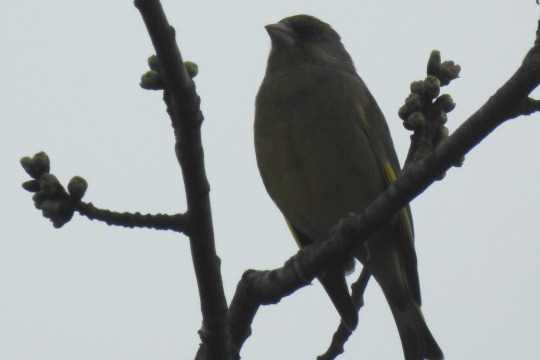





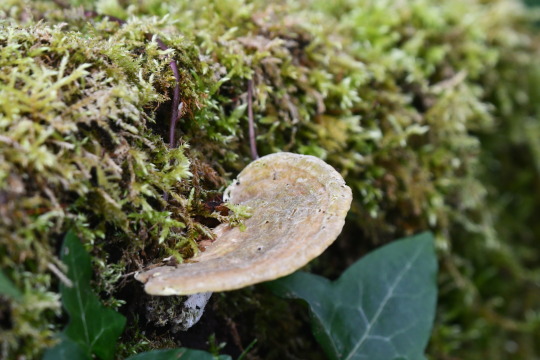
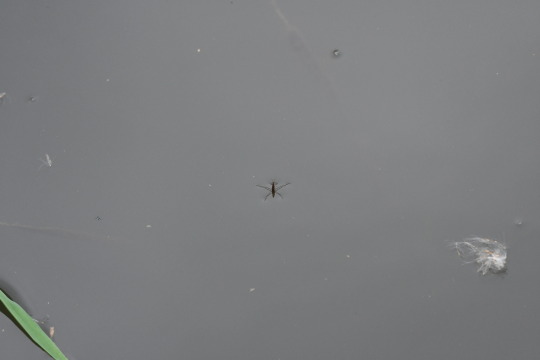
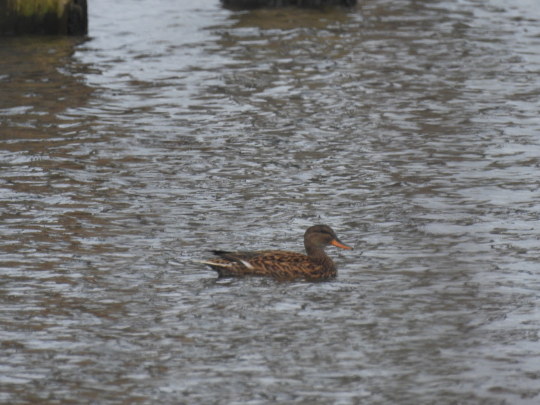
18th March 2024: Fishlake Meadows, Lakeside and others
Photos taken in this set are of; Song Thrush at Fishlake Meadows, Greenfinch when cutting through Lakeside, violet at Fishlake Meadows, beautiful views at both, mushroom and ivy at Fishlake Meadows, pond skater at Fishlake Meadows it was good to see a few of them and female Gadwall at Fishlake Meadows. Other highlights from the brilliant walk and time I spent at Fishlake Meadows and in Romsey today were Cetti's Warber and Chiffchaff near constant presences in sound and sight which was delightful, Water Rail, Great White Egret, Greylag Geese, Pochard, Treecreeper, Dunnock, Red Kite, Buzzard, Reed Bunting, Great Spotted Woodpecker heard, my first forget-me-not of the year, daffodils, white deadnettle, lots of lesser celandine and King Alfred's cake and turkey tail fungi with quite a few fungi enjoyed today. Great Crested Grebe, House Sparrow, Wren, Green Woodpecker heard and Grey Squirrel were other highlights on the cut throughs over Lakeside with my first ground ivy of the year seen between the locations.
#lakeside#fishlake meadows#lakeside country park#photography#birdwatching#romsey#eastleigh#cetti's warbler#forget-me-not#great spotted woodpecker#green woodpecker#song thrush#gadwall#greenfinch#violet#fungi#flowers#treecreeper#dunnock#red kite#buzzard#pochard#reed bunting#hampshire#england#uk#europe#world#nature#white deadnettle
10 notes
·
View notes
Text
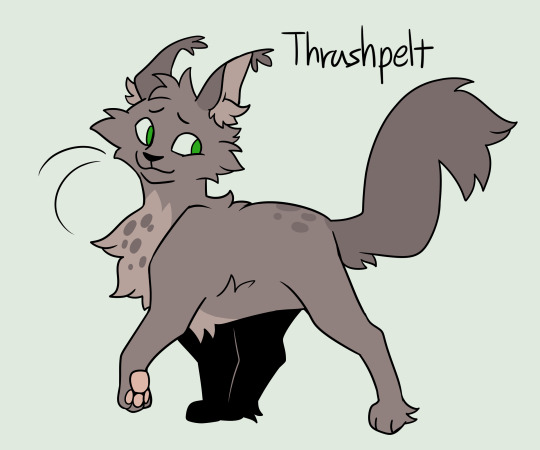

#Goosefeather's Curse#Tallstar's Revenge#Yellowfang's Secret#Crookedstar's Promise#Bluestar's Prophecy#Leopardstar's Honor#Redtail's Debt#code of the clans#Last Hope#kit#apprentice#warrior#deputy#elder#thrush#pelt#thrushpelt#tawny#spots#tawnyspots#tc#sc#warrior cats
26 notes
·
View notes
Photo
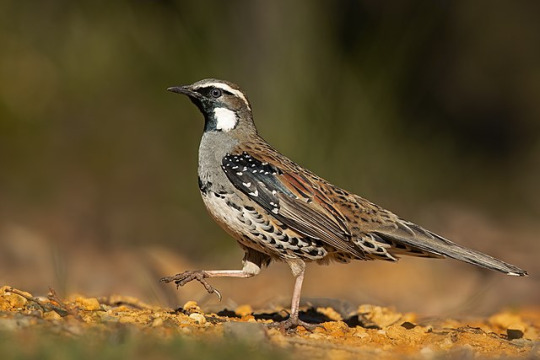
A new variant has been added!
Spotted Quail-thrush (Cinclosoma punctatum)
© JJ Harrison
It hatches from black, colored, eastern, female, high, long, low, male, open, pale, rocky, terrestrial, unobtrusive, and white eggs.
squawkoverflow - the ultimate bird collecting game
🥚 hatch ❤️ collect 🤝 connect
10 notes
·
View notes
Text
Prefix: Thrush-
A brown-and-white cat, possibly with a speckled or spotted pattern.

Description: there are several species of birds with the common name thrush in Michigan, including the grey-cheeked thrush, the hermit thrush, the Swainson's thrush, and the wood thrush. Thrushes are plump songbirds with plumage in various shades of brown that spend much of the time foraging on the ground for berries and insects in deciduous and mixed forests. Their undersides are white, and they have distinct patterns of speckling or spotting on their chests and flanks. Thrushes are secretive and aren't easily seen, but they fill the forests of Michigan with their beautiful, flute-like songs throughout the summer months until they migrate south for the winter.
2 notes
·
View notes
Text
i do love the fact that spotted ground-thrush is listed as rare because clearly the one at one of the local nature reserves has clearly never got that message
#or any of them whenever i've been at a location known for them#after a while it's like....oh it's another spotted ground-thrush#diary
5 notes
·
View notes
Text
So, I saw a post circulating here about the “extinction of birds in 2023“, with this picture attached
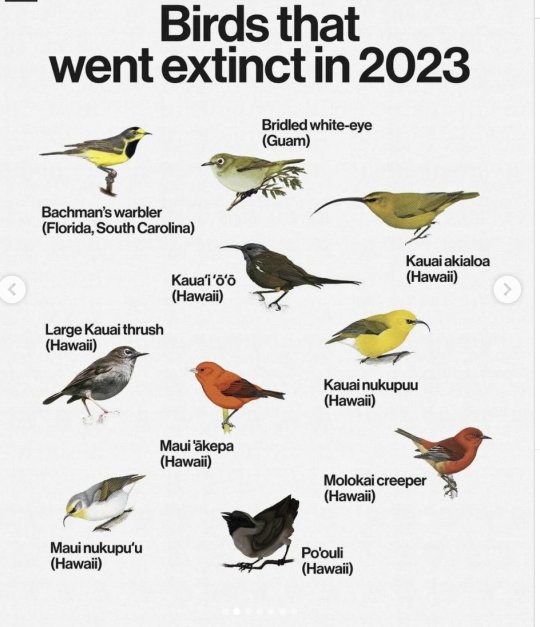
My, what a bold claim! All these poor birdies, “went extinct” in just one year alone? Why would such an outrageous, depressing and catchy claim be spread around?
Let’s fact check it.
All the species listed, Bachman’s wabler (Vermivora bachmanii, 1988 or 1980s), Kāmaʻo or large Kauaʻi thrush (Myadestes myadestinus, 1989 or 1987), Bridled white-eye (Zosterops conspicillatus, 1983 and 1983), Kauai ʻakialoa (Akialoa stejnegeri, 1969 or 1960s), Kauaʻi ʻōʻō (Moho braccatus, 1987 and 1987), Kauaʻi nukupuʻu (Hemignathus hanapepe, 1899 and 1899), Maui ʻakepa (Loxops ochraceus, 1988 and 1988), Kākāwahie or Molokaʻi creeper (Paroreomyza flammea, 1963 and 1963), Maui nukupuʻu (Hemignathus affinis, 1896* and 1996 ) and Poʻouli (Melamprosops phaeosoma, 2004 and 2004) are all, indeed, either extinct or possibly extinct, according to IUCN Red List of Threatened Species and U.S. Fish and Wildlife Service.
What are the dates after the scientific names? Well, those all are *last sightings* per IUCN Red List and USFWS accordingly. So, these birds were not seen for DECADES and in one case FOR MORE THAN A GODDAMN CENTURY. And sure as hell there is NO information about them very suddenly being gone all last year.
What’s the deal then? Where did this claim even come from? Well, likely from this article "21 Species Delisted from the Endangered Species Act due to Extinction" from U.S. Fish & Wildlife Service. It includes all the birds in the picture (with the last date of sight, listed above).
From the article: “The U.S. Fish and Wildlife Service is delisting 21 species from the Endangered Species Act due to extinction. Based on rigorous reviews of the best available science for each of these species, the Service determined these species are extinct and should be removed from the list of species protected under the ESA. Most of these species were listed under the ESA in the 1970s and 80s and were in very low numbers or likely already extinct at the time of listing.”
They didn’t ALL fucking suddenly drop dead all in the same year – if they did, as some other people have already pointed out, there would be an uproar EVERYWHERE. Ornithologists alone would not let it live down. They were officially delisted from endangered status by U.S. Fish & Wildlife Service that year, there was a proposition to do so back in 2021, too. Some were already declared extinct before by IUCN.
Despite not being seen for so long, they remained on the list of critically endangered for a long while, cause you cannot just immediately declare a species extinct. There’s no RTS unit amount number that goes to 0 once there’s nothing left; people keep checking for them over and over and over again. Sometimes it turns out that a species previously thought to be extinct is actually still out there. Attenborough's long-beaked echidna for example was last sighted SIXTY YEARS ago before being sighted again in 2023. It was thought to be extinct for a while, before 2007, when signs of its activity was spotted again. More often than not though, a species turns out to be actually very extinct, unfortunately – like in this case.
I cannot possibly know if the creators of this picture, or people that spread it on social media ever had good intentions behind it for awareness, however even if they did, it turned out to be nothing but very blatant misinformation, with a fearmongering effect. The only thing this achieves is not awareness of habitat destruction or pernicious tourist influence or climate change or what have you – the only thing this achieves is despair and panic. People already so casually fall into complete doomerism, they’re very used to hear bad news. And guess what doomerists do? Typically nothing. It renders people helpless. It’s not gonna make people get up and be ready for action, it, at best, would just make people feel sad and/or angry, or at worst, feed into the current alarming rise of ecofascism. NOTHING good comes out of this. At the very goddamn least, no one needs to lie to promote a goal.
The aim of the USFWS article, on the other hand, IS to make people aware about those animals that are already gone from the face of the planet, no matter how long ago, and that now we have to protect those animals that are critically endangered and still out there – to not have to repeat those tragedies.
Be very critical of what you see on the internet, especially if it’s sited with no sources. Especially-especially if it causes a strong emotional reaction. Lies and misinfo could only hurt the cause, no matter how noble. And please, be aware of your local wildlife status. Check in with it accoding to trusted sources.
[*sic, possibly a typo and it was meant to be 1996, other confirmed date listed there is 1989]
Addendum: I could not for sure find the uncredided (who woulda thunken that ppl that don't cite their sources would also not credit the artists) author(s) of the bird illustrations. If someone finds them, please, let me know!
Edit: Huge thanks to moosefinch for finding the sources for the artwork! I'll add their contribution below:
"Image sources!
The Kauai ʻakialoa, Kauaʻi ʻōʻō, Maui ʻakepa and Kauaʻi nukupuʻu are from Birds of the World.
The "Maui nukupuʻu" and "Molokaʻi creeper" illustrations are also Birds of the World, but are actually a female Kauaʻi nukupuʻu (the other being the male) and Laysan honeycreeper/Laysan ʻapapane respectively.
The bridled white-eye is by Lauren Helton according to this source.
Bachman's warbler is by Lynn Hawkinson Smith/smithhouse2 according to this Etsy listing.
The Poʻouli is by Christina Czajkowski."
#ah I just now see that the tumblr reblog of the pic and the twitter thread attached was deleted#yet the post is still in circulation. The damage lingers#so fucking irresponsible#fact check#misinformation#birds#bird#ecology#environmentalism#extinction#conservation#species conservation#animals#hawaiʻi#important
807 notes
·
View notes
Text
Jade Mountain Academy students
#2 - Icewing chapter

Winter, Prince
Tribe - Icewing
Winglet - Jade
Color - White and matte silver
Relatives - Princess Icicle (sister)
Clawmate(s) - Qibli (Sandwing)
Favorite subject - History
Least fav. subject - Literacy
Physical characteristics - corona-like crest of spines, shape and length irregular; well-defined musculature, average size
Other characteristics - owns pet scavenger (named "Bandit"), scavenger seems prone to escape (suggest pet care seminar); socially irritable (within reasonable parameters, may subside with acclimatization); unnaturally rigid sitting posture (suggest relaxation seminar)
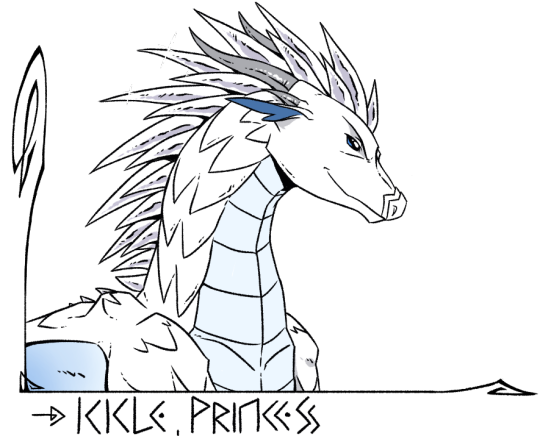
Icicle, Princess
Tribe - Icewing
Winglet - Gold
Color - White
Relatives - Prince Winter (brother)
Clawmate(s) - Sora (Mudwing)
Favorite subject - Exercise
Least fav. subject - Cultural Exchange
Physical characteristics - corona-like crest of spines, shape and length even; well-defined musculature, average size; very meticulously groomed
Other characteristics - socially domineering (no rule infractions, but suggest monitoring); washes talons and legs very often (possibly germophobic); unnaturally rigid sitting posture (suggest relaxation seminar); spotted loitering near staff offices several times (suggest monitoring)

Changbai
Tribe - Icewing
Winglet - Silver
Color - Sky blue and white
Relatives - none on site
Clawmate(s) - Boto (Rainwing), Thrush (Skywing)
Favorite subject - Art
Least fav. subject - Anatomy
Physical characteristics - split/branching horns; oblong body shape, long limbs, very tall and slender; currently greatest size of all students (measured from nose to tail tip)
Other characteristics - unnaturally rigid sitting posture (suggest relaxation seminar); most legible handwriting

Alba
Tribe - Icewing
Winglet - Copper
Color - White and light gray
Relatives - none on site
Clawmate(s) - Mindreader (Nightwing), Snail (Seawing)
Favorite subject - History
Least fav. subject - Science
Physical characteristics - horns twist up- and inward; slightly small size with average build
Other characteristics - appears fixated on Prince Winter and Princess Icicle (within socially acceptable parameters so far, but suggest monitoring); unnaturally rigid sitting posture (suggest relaxation seminar)

Ermine
Tribe - Icewing
Winglet - Quartz
Color - Light purple
Relatives - none on site
Clawmate(s) - Newt (Mudwing)
Favorite subject - Science
Least fav. subject - Exercise
Physical characteristics - dull and worn spines and scales; size average, weight near but within the upper limit of normal range
Other characteristics - socially anxious, state of spines implies nervous scraping habit (suggest counseling); reported friction with current clawmate (suggest monitoring, consider transfer to different sleeping cave); unnaturally rigid sitting posture (suggest relaxation seminar)
#wings of fire#wof#dragon#digital art#wof art#flawseer art#wof winter#wof icewing#wof icicle#wof changbai#wof alba#wof ermine#jade mountain academy#wof bandit
470 notes
·
View notes
Text
A mix of you and me
choso x reader
contains: choso x female reader, daddy kink, slight breeding kink, wanting children

Choso who makes it his life mission to make you happy, to make you smile, to protect you, to please you in any way possible
Choso who was fucking you so good, each thrush into your pussy making you float in a sea of pleasure
Choso who makes you feel so safe, so protected and loved. That you accidentally call him daddy while he's balls deep in you, how calling him daddy made him throb and come on the spot. Choso himself not understanding why you calling him that had such an effect over him
Choso who can't stop but think of making his family bigger. Before it was him and his little brothers, he only cared about them. That was until he met you, and now you were apart of that family.
Choso who can't stop himself of thinking of a child, made from him and you. A son you'd dote on or a daughter he'd spoil rotten (a part of him wanting both, and more)
Choso who was in the middle of fucking you so good you thought he would fuck the soul out of your body, suddenly stopping leaving you confused
Choso who's looks absolutely feral staring at you, eyes filled with love, lust and devotion. Asking you to call him his name. You being so confused, calling him Choso.
Choso grinning, voice suddenly husky and deep asking you to call him what you said last time. Rubbing your clit slowly to tease you. You calling him daddy, which just unlocks something in him
Daddy who's suddenly fucking you harder, faster, deeper, promising to make you a mommy.
Choso who's always been a family man, wanting more. He already has siblings.
Choso who when he looks at you smiling at him, flushed and panting after he just came in you, nodding, saying you wants that aswell.
Choso and you making it your mission to expand your family, both of you wanting to see the other playing and doting on a child made from a bit of you, and a bit of him
#jjk choso#choso kamo#choso kamo smut#choso kamo x reader#choso x y/n#choso x female reader#choso#choso x you#kamo choso x reader#kamo choso
274 notes
·
View notes
Text
Aesthetic sensibilities are deeply subjective, and hard to acknowledge and analyse clearly. They take root in us from the moment we’re born. They bind us to a particular view of the landscape, something we begin to think of as ‘natural’ or, at least, benign. What we see as children, particularly where we grow up, becomes what we want to continue to see, and what we want our children to see. Nostalgia, and the sense of security that nostalgia brings, binds us to the familiar. We are persuaded, too, by our own absorption in this aesthetic that what we are seeing has been here for ever. We believe the countryside around us, or something very similar to it, has persisted for centuries and the wildlife within it, if not exactly the same, is at least a fair representation of what has been here for centuries. But the ecological processes of the past are hard for the layman – and often even conservation professionals – to grasp.
We are blinded by the immediacy of the present. We look at the landscape and see what is there, not what is missing. And if we do appreciate some sort of ecological loss and change, we tend to go only as far back as our childhood memories, or the memories of our parents or grandparents who tell us ‘there used to be hundreds of lapwings in my day’, ‘skylarks and song thrushes were ten-a-penny’, ‘the fields round here used to be red with poppies and blue with cornflowers’, ‘cod was the poor man’s fish when I was a nipper’. We are blind to the fact that in our grandparents’ grandparents’ day there would have been species-rich wildflower meadows in every parish and coppice woods teeming with butterflies. They would have heard corncrakes and bitterns, seen clouds of turtle doves, thousands of lapwings and hundreds more skylarks. A mere four generations ago they knew rivers swimming with burbot – now extinct in Britain – and eels, and their summer nights were peppered with bats and moths and glow-worms. Their grandparents, in turn, saw nightjars settling on dusty country lanes and even hawking for moths around the street lamps in towns, and spotted flycatchers in every orchard, and meadow pipits everywhere from salt-flats to the crowns of mountains. They saw banks of giant cod and migrating tuna in British waters. They saw our muddy North Sea clear as gin, filtered by oyster beds as large as Wales. And their grandparents, in turn, living at the time of the last beaver in Britain, would have known great bustards, and watched shoals of herring five miles long and three miles broad migrating within sight of the shore, chased by schools of dolphins and sperm whales and the occasional great white shark. We don’t have to look too deeply into the history books, into contemporary accounts, for scenes dramatically different to our own to be normal. Yet we live in denial of these catastrophic losses.
Isabella Tree, Wilding: The Return of Nature to a British Farm
59 notes
·
View notes
Text

March 31, 2024 - Happy Easter/Spring! Another Assortment of Eggs
Clockwise from top: Common Loon (brown with dark brown spots), Eastern Kingbird (white with dark brown spots), Cetti's warbler (reddish-brown), Grey-cheeked Thrush (light blue with tiny light brown spots)
If you missed the last ten Easter/spring posts and would like to see some more eggs, you can find them here: 2023, 2022, 2021, 2020, 2019, 2018, 2017, 2016, 2015, and 2014
#eggs#spring#easter#illustration#art#common loon#eastern kingbird#cetti's warbler#gray-cheeked thrush
54 notes
·
View notes
Text


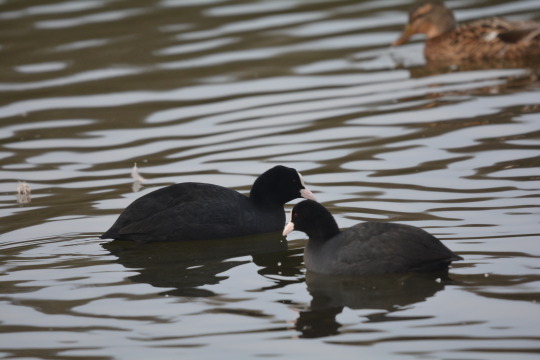


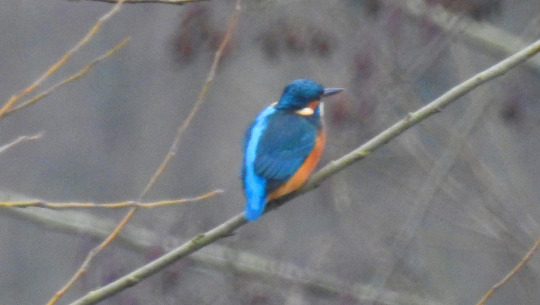




04/01/2024: Lakeside and home
Flora and fauna photos taken in this set are of: 1. One of a few pretty Robins I saw on the walk and in the garden today, kissed by the soft morning sun. It was good to see one get a worm at one point. 2. Moss on wood. 3. Coots and Mallard. 4. Female and male Mallard on a flooded area, always an enchanting sight. 5. Some fascinating and striking comfrey leaves which were good to see. 6 and 8. My first Kingfisher and Nuthatch of the year which I got smashing views of, not birds I see at Lakeside all the time that I felt I might have a chance of adding to my year list and I was thrilled I did. I am on a brilliant run for seeing the Kingfisher at Lakeside currently and it was exceptional to watch this radiant dainty gem of a bird dash across Concorde and beach lakes, fish and from standing the other side of beach lake from the benches seeing it hover in the air above the lake and the perch on one of the benches was surreal and amazing. Only the second time I've ticked Kingfisher one of my very favourite birds for the year at Lakeside after New Year's Day 2016 when it hovered like it did today inspiring me onto a brilliant year of birds so it's great to get it under the belt for 2024 today. For the charming Nuthatch it's the second year running I've ticked it for the year here. 7. One of a few Song Thrushes encountered this morning seeing and hearing their melodious song one of my favourites well a perfect soundtrack to a great long morning out embraced by nature. 9. Greylag Goose. 10. Worm out the front this morning one of a few seen.
My first Bullfinches, a fair few Wrens and Tufted Duck with great views of a male of the year were also great to see on my walk taking my year list to a pleasing 55, it was exceptional to get astonishing views of three or four Bullfinches a few times both the sensational crimson chested male and female again one I don't often see at Lakeside so this was a stunning experience. Other highlights on the walk were Coal Tit, Long-tailed Tit, Great Tit, Blue Tit, Goldfinch, Siskins a big star species of my young year, Chaffinch, Dunnock and Jay others I've started the year well for, Collared Dove, very strong Redwing views, Blackbird, Green Woodpecker and Great Spotted Woodpecker seen and heard so well again, Herring Gull, Moorhen, Great Crested Grebes including more amorous looks between the pair again and Cormorant. It was good to see Cormorant flying from home today too with Goldfinch and Collared Dove enjoyed at home too. Plant highlights on the Lakeside walk were wild carrot, pineappleweed, gorse, cleavers, catkins, mistletoe, rose hips and clover leaves with firethorn berries and lavender enjoyed in the garden in the lovely morning sun. Grey Squirrels seen well again, my first Brown Rat of the year and a variety of fungi including the turkey tail were also good to see at Lakeside.
#photography#birdwatching#bullfinch#nuthatch#wren#kingfisher#tufted duck#great crested grebe#jay#great spotted woodpecker#green woodpecker#robin#song thrush#siskin#coal tit#birding#2024#january#outdoors#walking#powerful#happy#nature#walk#europe#england#hampshire#uk#world#pineappleweed
3 notes
·
View notes
Text
Rosebush!
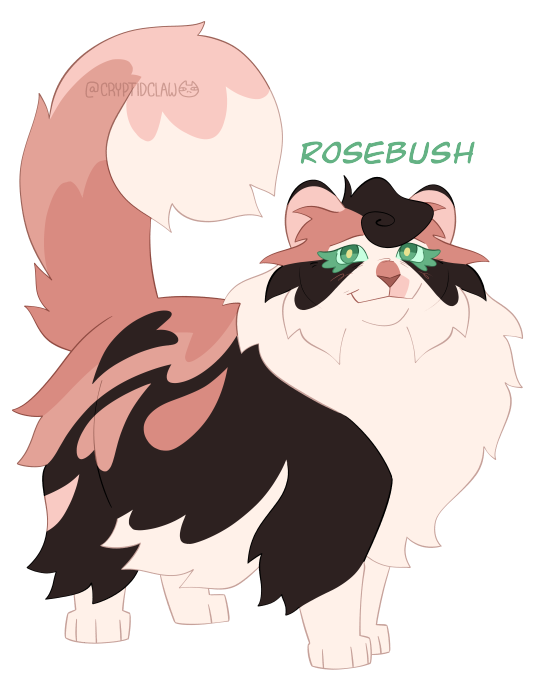
Design Notes:
Its pretty much the exact same as the last one, I just redrew her <3
Character Bio:
Rosebush
(Rosetail)
Lesbian; she/her
Age as of 1st arc's beginning: 8 cycles, 10 moons; ~52 Hyrs
Title meaning: -bush = A sturdy cat, a cat you can depend on; is especially good at building; a cat who spends much of their time helping around camp and fixing dens
Caretaker of Thunder Order
Mentor: Tawnyspots
Mother: Poppydawn
Father: Windflight
Siblings: Sweet
Half Siblings: Dappledew; Thrushcloud
Kits (outsider sire): Redtail; Spottedleaf; Willowchime
Grandkits: Darkstripe; Sandstorm; Poppy; Flint; Graybelly; Sootfur; Rainwhisker; Sorreltail
Other notable kin: Downnose (niece); Cricketstep (nibling); Star Ravenscourge (nephew); Dustpelt (nephew)
Extra notes:
She defo has a secret outsider gf or something, she deserves a gf. If I wasnt attached to Snowstorm and Thistleclaw's fucked up relationship plot, Rose would have been Snow's mate.
Character Summary:
Rosebush is a sort of jack of all trades in the Caretaker role, she is very big and strong, she's one of the best builders in the Order, and she does a lot of the heavy lifting around the camp. She also is very loving and empathetic and loves caring for kits, elders and just anyone who needs some love and care. She's a big buff lady who loves and cares about everyone.
Rose is the mother of Redtail, Spottedleaf and Willowchime, she always wanted kits so she found an outsider to sire a litter! Its pretty sad that her kits had such short lives... at least Red and Willow are carried on through their children.
Rose is also in cahoots with Bluefrost and Thrushcloud about Thistleclaw's assassination. She doesn't join in herself, but she instead stays in camp with Spotted, she knew her daughter needed her.
Rose is one of Bluefrost's best friends, Blue, Snowstorm, Thrushcloud and Rosebush are/were a tight nit friend group, and were almost always spending time together. The deaths of Snow, then Rose and then Thrush is one of the biggest blows to Bluefrost's mental health.
Rosebush dies early in the first arc due to illness, though she lasts longer than in canon bec I think her death would be more impactful if her relationship with Bluefrost, her kits and the Order was established first.
...
[Image ID: A digital drawing of Rosetail from Warrior Cats. She is standing with her right side showing, she has a calm expression and a smile on her face. She is a big chubby tortoiseshell and white molly, she is mostly black, with pinkish-orange spotting on her back, tail and the top of her face, there are pink spots on her sides in heart and droplet shapes, there are also a black spot like this on her flank. The lower half and middle of her face is white, and this continues down her fluffy neck and stomach, her paws and tail tip are also white. Her eyes are a teal green color, her inner ears are pink, her nose is dark pink and her eyelashes are green like her eyes./End ID]
#cryptidclaw's warriors au#rise of change#rosetail#rosebush#warrior cats#warrior cats design#warriors
310 notes
·
View notes
Photo

A new variant has been added!
Spotted Palm Thrush (Cichladusa guttata)
© Joseph Wolf
It hatches from black, brown, dense, musical, other, rollicking, short, shy, similar, tame, white, and woodland eggs.
squawkoverflow - the ultimate bird collecting game
🥚 hatch ❤️ collect 🤝 connect
0 notes
Text
BOTD: Townsend's Solitaire

Photo: Grigory Heaton
"Solitaires are slim, long-tailed thrushes that perch upright in trees. As the name suggests, they are usually seen alone. Feeding mostly on berries in winter, each bird maintains its solitary status by defending a winter territory, staking out a supply of berries in a juniper grove or similar spot. These wintering birds often give a soft bell-like callnote; in summer (and sometimes in winter as well) they give voice to a complex song of clear musical warblings."
- Audubon Field Guide
#birds#townsend's solitaire#birds of north america#north american birds#solitaires#thrushes#passerines#birds of the us#birds of canada#birds of mexico#birding#birdblr#birblr#bird watching#bird of the day#Myadestes townsendi
63 notes
·
View notes